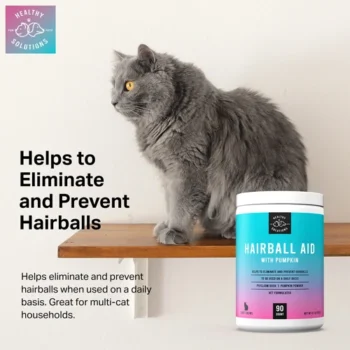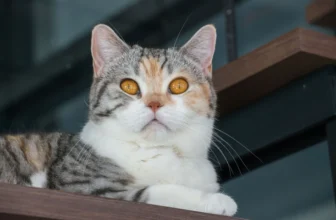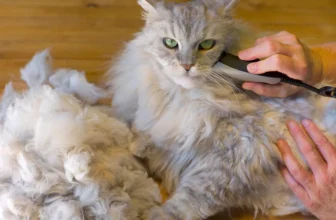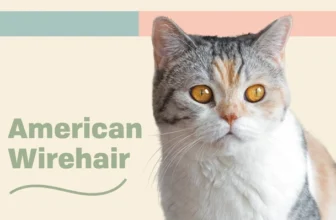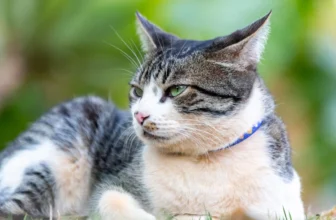As cat owners, we adore the delightful sight of our furry little friends grooming themselves. However, all that licking and grooming doubles as their self-cleaning mechanism, leading to the unfortunate development of hairballs. If you own an American Wirehair, you may have noticed that these feline friends are particularly prone to hairballs compared to other cat breeds. Fear not! In this article, we’ll explore the root causes of hairballs for American Wirehairs, prevention tactics, treatment options, and when it’s time to call your vet. Let’s dive in and discover how to keep your American Wirehair healthy and happy!
What Causes Hairballs in American Wirehairs?
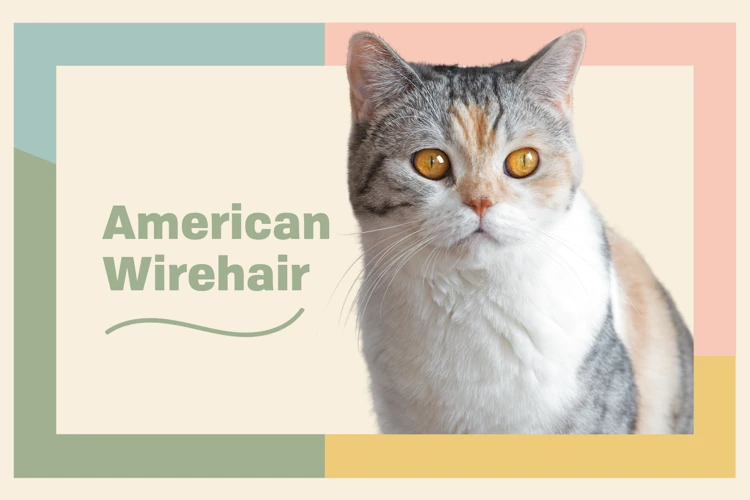
Hairballs are a common issue experienced by most American Wirehair cats. These furry felines are known to groom themselves excessively, which could result in hairball formation. However, this is not the only reason why American Wirehairs suffer from hairballs. In this section, we will explore the various causes of hairballs, including the importance of grooming, dietary factors, and medical issues, that affect American Wirehairs. It is important to note that with regular grooming and proper care, hairballs can be easily prevented. Check out our American Wirehair brushing guide for useful tips on minimizing hairball formation.
The Importance of Grooming
Grooming is an essential aspect of American Wirehair care that can significantly help to prevent hairballs from forming. Regular brushing and combing of your pet’s fur help to remove loose and dead hair before it can be ingested. Grooming helps to distribute natural oils throughout the fur, which prevents matting and tangling.
Brushing and combing: One of the most effective ways to groom your American Wirehair is through regular brushing and combing. A metal comb with wide teeth is best for removing loose hairs, while a slicker brush works great for removing dirt and debris. Grooming should be done gently but thoroughly, focusing on the underbelly, legs, and tail, which are common areas for matting.
Bathing: Regular bathing is also essential for preventing hairballs and keeping your pet’s fur clean and healthy. Use a high-quality pet shampoo and conditioner designed specifically for American Wirehairs. Bathe your pet no more than once a month to avoid drying out their skin. To learn more, you can check out our article on American Wirehair regular baths.
Paw care: Although hairballs are caused by fur ingested during grooming, don’t forget about your pet’s paws. Long hair around the paws can become matted and painful. Trimming your American Wirehair’s claws and the hair around the paws can help to prevent hairballs and other hygiene issues. You can check out our trimming American Wirehair claws guide to learn more.
Ears and teeth: Proper ear cleaning and dental care are also essential parts of grooming an American Wirehair. Regular ear cleaning can prevent infections, while proper dental care can prevent tooth decay and gingivitis. You can learn more by reading our cleaning American Wirehair ears and American Wirehair dental tips articles.
Diet: Lastly, diet plays a significant role in preventing hairballs in American Wirehairs. Feeding your pet high-quality food that is rich in fiber can help to regulate their digestive system and reduce hairball formation. You can learn more about dealing with shedding and dietary choices in our dealing with shedding American Wirehair tips article.
By following a regular wirehair grooming schedule and making necessary dietary changes, you can help to prevent hairballs in your American Wirehair.
Dietary Factors
What your American Wirehair consumes can play a crucial role in the formation of hairballs. A diet that lacks essential nutrients can lead to hair loss and unhealthy skin, making your pet prone to developing hairballs. Therefore, providing your feline friend with a high-quality, well-balanced diet is essential to prevent hairball formation.
One dietary factor that contributes to hairball formation is insufficient water intake. When a American Wirehair cat fails to drink enough water, their digestive tract doesn’t work optimally, causing dehydration, constipation, and hairball build-up. To prevent this from happening, ensure your cat has access to clean water at all times and consider mixing wet food into their diet, as it contains more moisture than dry food.
Another critical dietary factor is your cat’s consumption of oils and fats. Too little fat in your American Wirehair’s diet can lead to dry skin, while an excessive amount of fat can cause diarrhea and lead to obesity. Both of these conditions lead to excess shedding and eventual hairball formation. To strike a balance, consult your vet to determine the correct amount of fat to feed your cat.
Additionally, feeding your American Wirehair too much fiber can lead to constipation, hairball formation, and other health problems. On the other hand, too little fiber can cause diarrhea and indigestion. It’s essential to know the ideal amount of fiber your feline friend should consume daily. Again, your veterinarian can guide you on the right amount of fiber to feed your pet.
Finally, some foods can cause allergic reactions in American Wirehair cats, which results in excessive scratching and licking, leading to hair loss and hairball formation. If you suspect your cat has a food allergy, schedule a visit to your veterinarian to determine the specific allergen and adjust your cat’s diet accordingly.
In conclusion, providing your American Wirehair with a diet that is rich in necessary nutrients, moderate in fat and fiber, and with access to clean water at all times can be instrumental in preventing hairball formation and ensuring your furry friend’s overall health and well-being.
Medical Issues
Hairballs in American Wirehairs are commonly caused by excessive grooming and dietary factors, but there are also certain medical issues that can lead to a higher risk of hairball formation. If your American Wirehair is experiencing chronic or severe hairballs, it may be worth speaking to a veterinarian to identify any possible underlying medical conditions that could be contributing to the issue.
Here are some common medical issues that can increase the chances of hairballs:
- Hypothyroidism: This condition occurs when the thyroid gland isn’t producing enough hormones, leading to a slower metabolism. A slower metabolism can cause issues with digestion and proper shedding of hair, which can result in increased hairballs.
- Inflammatory bowel disease: This is a chronic condition that can cause inflammation in your cat’s digestive system. This inflammation can lead to difficulty processing food, which can result in hairballs
. If your cat is experiencing frequent hairballs and other digestive issues, it may be worth getting them checked for IBD.
- Excess stomach acid: If your cat has an excess of stomach acid, it can cause inflammation in the stomach lining. This inflammation can make it harder for hairballs to pass through, resulting in vomiting or other digestive issues.
While these medical issues can be more challenging to manage than dietary or grooming-related causes, they can often be managed with medication or changes to your cat’s diet. If you suspect that your American Wirehair may be suffering from any of these medical issues, it is essential to speak with a vet to determine the best course of treatment.
If you’re worried about your cat’s excessive grooming habits, make sure to speak to your veterinarian. They may be able to recommend some grooming tools or products to help prevent hairballs. Additionally, certain skin problems can lead to excessive grooming, which can, in turn, lead to hairballs. You can learn more about this topic in our article on American Wirehair skin problems. Also, consider using the right shampoo and conditioner to keep your American Wirehair’s fur healthy and minimize the risk of hairballs. You can find out which products are best in our article on the best shampoo and conditioner for American Wirehairs.
Preventing Hairballs
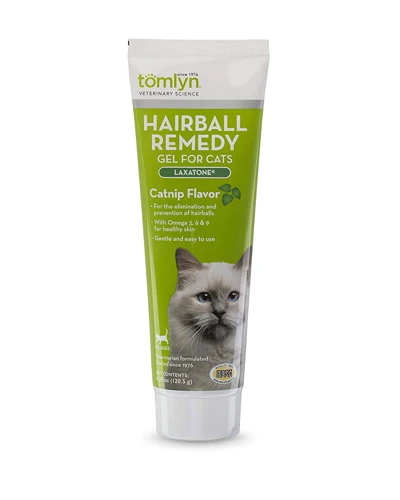
As an American Wirehair owner, preventing hairballs is an important aspect of keeping your feline friend healthy and happy. Luckily, there are several steps you can take to minimize the risk of hairballs and make sure that your cat stays comfortable. By following these preventative measures, you can reduce the likelihood of your Wirehair developing hairballs and mitigate the negative effects they can have on your pet’s health. Let’s explore some of the best ways to keep your cat hairball-free.
Regular Grooming: One of the most effective ways to prevent hairballs in American Wirehairs is to groom your cat regularly. Proper grooming helps remove loose hair and dirt from your pet’s coat, preventing your wirehair from ingesting too much hair when grooming themselves. Grooming brushes and combs specifically designed for Wirehairs can be found in pet stores or online here.
Regular Grooming
Keeping your American Wirehair well-groomed is one of the most essential ways to prevent hairballs. Regular grooming helps remove excess hair and prevent it from being ingested by your cat. Here are some tips for regular grooming that will help reduce the likelihood of hairballs:
- Brushing: Brush your American Wirehair at least once a week to remove loose hair and prevent tangles. Make sure to use a brush that is designed for cats and be gentle to avoid causing any discomfort.
- Bathing: Bathing your cat may not be necessary unless they have long hair that is prone to matting. If you do bathe your cat, make sure to use a cat shampoo and avoid getting water in their ears.
- Trimming: Regular trimming of your cat’s hair can help prevent matting and reduce the amount of hair your cat ingests. If you are uncomfortable trimming your cat’s hair, consider taking them to a professional groomer.
Remember, while grooming is essential for preventing hairballs, over-grooming can actually lead to hair loss and other skin issues in cats. Stick to a regular grooming routine that meets your cat’s needs without overdoing it. By following these grooming tips, you can reduce the likelihood of hairballs and keep your American Wirehair healthy and happy.
Dietary Changes
One of the most effective ways to prevent hairballs in your American Wirehair is by making certain dietary changes. This involves feeding your cat food that is specifically designed to reduce hairballs. You can also add certain supplements to their diet.
One way to make dietary changes is to introduce high-fiber food into your cat’s diet. You can ensure that the cat gets enough fiber by feeding them canned or dry food that contains 2% to 4% fiber. Most cats consume fiber from leafy greens, but since American Wirehairs are indoor cats, they may not receive enough fiber from their regular food.
Another dietary change involves increasing water intake. Ensuring that your cat drinks adequate water can help reduce hairballs. You can provide your cat with fresh drinking water always and incorporate wet food into their diet.
Additionally, you can introduce digestive supplements into your cat’s diet. These supplements can help in digestion and reduce the formation of hairballs. Some examples of such supplements include enzymes, probiotics, and plant-based agents.
It’s important to note that just as with any other dietary change, you should introduce new food or supplements to your cat’s diet gradually and monitor their reaction, especially if they have an underlying health condition.
Here’s a table summarizing the dietary changes that can help prevent hairballs in your American Wirehair:
| Dietary Change | Description |
|---|---|
| High-fiber food | Feed your cat food containing 2%-4% fiber to prevent the formation of hairballs. |
| Increased Water Intake | Provide fresh drinking water always and incorporate wet food into their diet to aid in digestion. |
| Digestive supplements | Provide your cat with digestive supplements such as enzymes, probiotics, and plant-based agents to help aid in digestion and reduce hairball formation. |
By making these dietary changes, you can help prevent hairballs in your American Wirehair.
Reducing Stress
Stress can be a major contributing factor to hairball formation in American Wirehairs. Here are some effective ways to reduce your cat’s stress levels:
- Environmental Enrichment: Create a stimulating environment for your American Wirehair by providing toys, scratching posts, and regularly rotating their playthings to keep things fresh and interesting. Consider using a diffuser with pheromones, like Feliway, to help calm your cat down.
- Designated Safe Spaces: Create a cozy and comfortable hiding spot for your cat to retreat to when they’re feeling overwhelmed or stressed out. This could be a box, a soft bed, or a secluded area of your home that’s just for them.
- Maintain a Routine: Establishing a set routine and sticking to a regular feeding and play schedule can help minimize daily stress. American Wirehairs are creatures of habit, and they’re less likely to become anxious when they know what to expect.
- Minimize Disruptions: Try to minimize any loud noises or disruptions in your home, as sudden changes or loud noises can cause stress and anxiety in your American Wirehair.
By regularly implementing these strategies and following the tips outlined in this article, you can help prevent hairballs in your beloved American Wirehair and provide them with a happier, healthier life.
Treating Hairballs
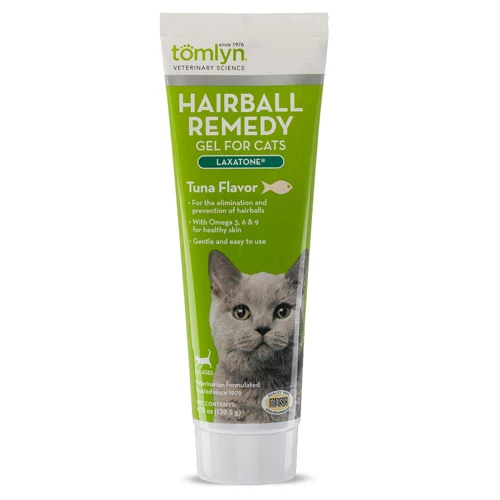
It’s not uncommon for American Wirehairs to develop hairballs, but fortunately, there are various methods for treating and preventing them. If you’ve noticed your feline companion exhibiting symptoms of hairballs, it’s essential to act quickly; if left untreated, hairballs can lead to gastrointestinal issues and other more severe complications. Below, we’ll explore some effective solutions for treating hairballs in American Wirehairs and ensuring your cat’s health and happiness.
Petroleum Jelly/Laxatives
To help your American Wirehair pass hairballs, you can try using either petroleum jelly or laxatives. These options can work to lubricate your cat’s digestive tract or stimulate bowel movements to encourage the passage of hairballs. Here are some important things to note about each option:
Petroleum Jelly:
- Apply a small amount of petroleum jelly to your cat’s nose or paw to encourage them to ingest it.
- Alternatively, you can spread the petroleum jelly onto your cat’s forepaws, and they should naturally lick it off while grooming themselves.
- Make sure to use a small amount of petroleum jelly, as too much can have negative effects on your cat’s health.
- Monitor your cat closely after giving them petroleum jelly to ensure they do not experience any adverse reactions.
Laxatives:
- Speak with your veterinarian to determine the best type of laxative for your American Wirehair.
- Commonly recommended laxatives for cats include lactulose, psyllium, and malt-based products.
- Follow the dosing instructions provided by your veterinarian carefully to avoid over-dosing your cat.
- Monitor your cat closely after administering a laxative and make sure to provide plenty of water to prevent dehydration.
It is important to remember that both petroleum jelly and laxatives should only be used in moderation and under the guidance of a veterinarian. If your cat continues to experience hairballs despite preventative measures and the use of these treatments, it may be time to seek veterinary care.
Fiber Supplements
If you’re looking for a natural approach to treating hairballs in your American Wirehair, you may want to consider adding fiber supplements to their diet. Fiber is important for digestive health and can help move hair through the digestive tract, reducing the likelihood of hairballs forming.
Examples of Fiber Supplements
Here are some examples of fiber supplements that can be added to your cat’s diet:
| Fiber Supplement | Description | Recommended Dosage |
|---|---|---|
| Pumpkin | Pumpkin is a great source of fiber and can be added to your cat’s food as a natural way to move hair through the digestive tract. | 1-2 teaspoons per day |
| Psyllium Husk | Psyllium husk is a soluble fiber that can help regulate bowel movements and reduce hairball formation. | 1/8 teaspoon per day, mixed with food |
| Inulin | Inulin is a prebiotic fiber that can help support digestive health and reduce hairball formation. | 1/4 teaspoon per day, mixed with food |
Important Considerations
Before adding any fiber supplement to your cat’s diet, it’s important to talk to your veterinarian to ensure it’s safe and appropriate for your pet. Additionally, it’s important to gradually introduce any new supplement to their diet to prevent any digestive upset.
Incorporating fiber supplements into your American Wirehair’s diet can be a natural and effective way to prevent hairballs. Be sure to introduce any new supplement gradually and under the guidance of your veterinarian.
Prescription Medications
When it comes to treating hairballs in your American Wirehair, prescription medications may be necessary if other methods have failed. Your vet may recommend one of the following prescription medications:
| Medication Name | Function |
|---|---|
| Miralax | Softens stool for easier passage and prevents constipation, which can contribute to the formation of hairballs. |
| Cisapride | Helps to stimulate the digestive activity in the intestines, increasing the movement and passage of hairballs. |
| Prednisone | Can be used to reduce inflammation in the digestive tract, helping to pass hairballs through the system more easily. |
| Lactulose | Helps to soften the stool and prevent constipation, reducing the likelihood of hairballs forming. |
It’s important to always follow your vet’s instructions and dosage guidelines when administering prescription medications. These medications should only be given under the guidance of a veterinarian, and your cat’s health should be monitored closely throughout the treatment process.
It’s also worth noting that prescription medications may not be necessary for every American Wirehair with hairball issues. In many cases, implementing preventative measures such as regular grooming and dietary changes can effectively manage or eliminate hairball-related problems.
When to See a Vet
As a responsible pet owner, it’s important to know when to seek veterinary care for your American Wirehair if they are experiencing hairball-related issues. In general, if your cat is unable to pass a hairball or is showing signs of distress such as vomiting, loss of appetite, lethargy, constipation, or diarrhea, it’s time to seek professional help.
If your cat is attempting to vomit but is unable to bring up the hairball, this can be a sign of a blockage in the digestive tract and is a medical emergency. In this case, take your cat to a vet immediately for treatment. Delaying could lead to serious complications such as intestinal perforation or infection.
Additionally, if your cat is consistently producing hairballs, it’s best to consult with your veterinarian to determine if there is an underlying medical issue that needs to be addressed. Your vet may perform tests to rule out gastrointestinal problems or prescribe medication to help prevent future hairballs.
In some cases, hairballs may be a sign of a more serious medical condition such as inflammatory bowel disease (IBD) or liver disease. If your cat’s hairballs are accompanied by other concerning symptoms such as weight loss or anemia, it’s important to seek veterinary care to rule out these conditions.
If you’re ever unsure whether your cat’s hairball situation warrants a trip to the vet, it’s better to err on the side of caution and seek professional help. Your cat will thank you for it.
Conclusion
After reading through this article, it’s clear that hairballs can be a pesky problem for American Wirehairs and their owners. However, there are steps that can be taken to prevent and treat them.
Grooming regularly, whether it’s brushing or bathing, can be a helpful way to prevent hairballs from forming. Additionally, making sure your American Wirehair has a healthy diet that includes enough fiber and moisture can go a long way in reducing hairballs. Stress reduction techniques such as providing comfortable hiding spots or spending more time with your pet can also be beneficial.
If your American Wirehair does end up developing a hairball, there are a variety of remedies to try. Petroleum jelly or laxatives can help lubricate the digestive tract and make it easier for the hairball to pass through. Fiber supplements can also be added to your pet’s diet to promote digestion. In more severe cases, prescription medications may be needed.
It’s important to keep an eye on your American Wirehair’s behavior and note any noticeable changes or discomfort. If hairballs persist or your pet exhibits symptoms such as vomiting, lethargy, or a loss of appetite, it’s time to see a vet as soon as possible. Your veterinarian can recommend the best treatment plan and ensure that your furry friend is healthy and happy.
In conclusion, dealing with hairballs in American Wirehairs may seem daunting, but with proper prevention and treatment methods, it’s possible to limit their impact. Remember to groom regularly, provide a balanced diet, and reduce stress levels whenever possible. And in the event that a hairball does cause concern, don’t hesitate to seek veterinary care.
Frequently Asked Questions
1. How often should I groom my American Wirehair?
It is recommended to groom your American Wirehair at least once a week to prevent hairballs from forming.
2. Can dietary changes really prevent hairballs?
Yes, feeding your American Wirehair a specialized diet high in fiber can greatly reduce the formation of hairballs.
3. Is stress a common cause of hairballs in American Wirehairs?
Yes, stress can cause excessive grooming and ingestion of hair, leading to hairball formation. Reducing stress can help prevent hairballs.
4. Should I give my American Wirehair petroleum jelly to treat hairballs?
Petroleum jelly or laxatives can be used as a short-term solution, but it is important to consult with your vet before administering any medication or supplement.
5. My American Wirehair has a hairball stuck and can’t seem to cough it up. What should I do?
If your American Wirehair is experiencing difficulty passing a hairball, it is important to seek veterinary attention immediately. This could be a sign of a blockage.
6. How does grooming help prevent hairballs?
Grooming removes loose hair and prevents it from being ingested, reducing the likelihood of hairballs forming.
7. Are there any over-the-counter products that can help prevent hairballs?
There are a variety of hairball prevention products available over-the-counter, such as specialized diets, treats, and supplements. It is important to consult with your vet before using any new product.
8. What medical issues can cause hairball formation?
Medical issues such as digestive disorders can lead to hairball formation. Consult with your vet if you suspect your American Wirehair is experiencing a medical issue.
9. How can I reduce my American Wirehair’s stress?
Reducing stress can be achieved through environmental enrichment, such as providing toys and scratching posts, and spending quality time with your cat.
10. Can all cat breeds form hairballs?
While all cats are susceptible to hairballs, certain breeds with longer fur, such as the American Wirehair, may be more prone to hairball formation.

